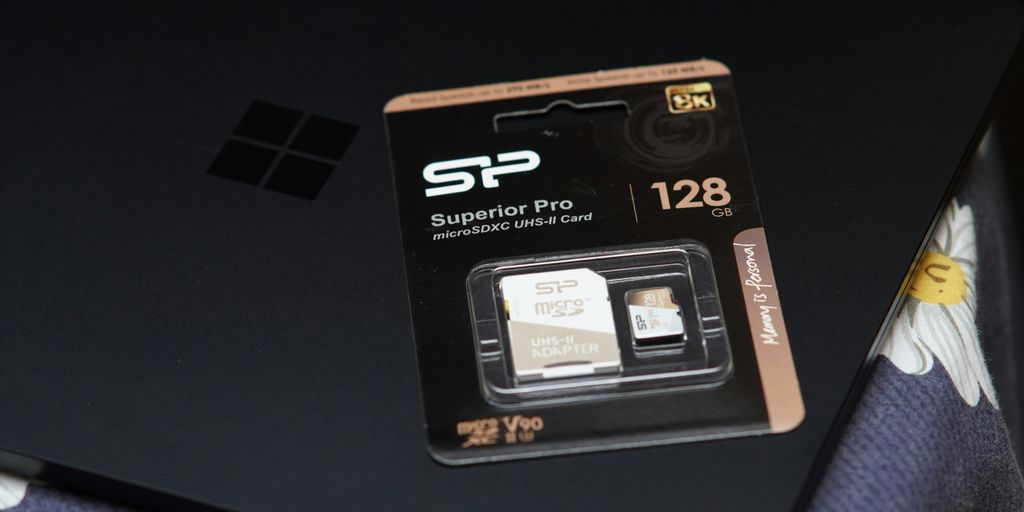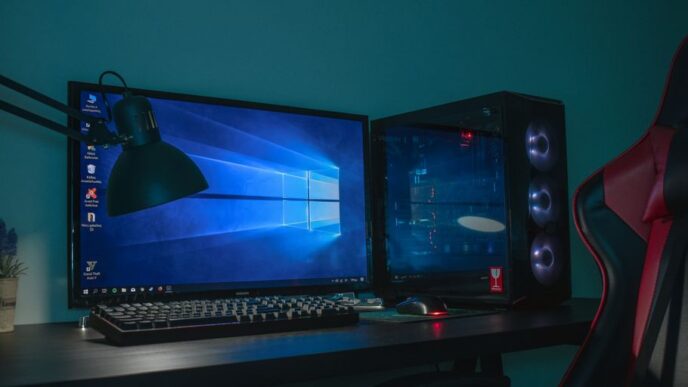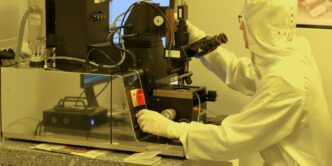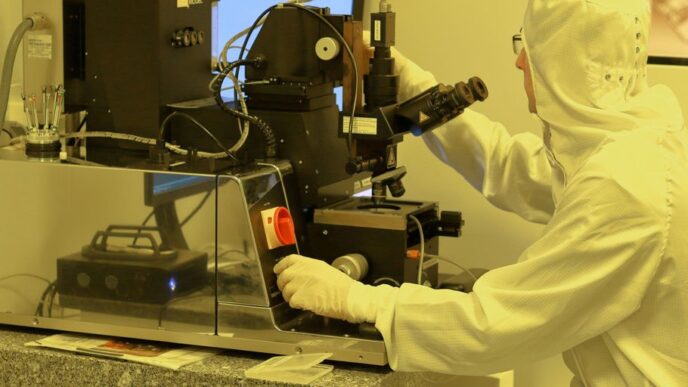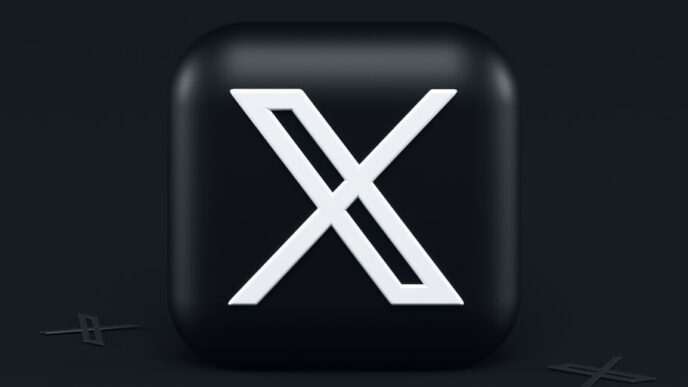Alright, so everyone’s buzzing about the PS5 Pro, right? It feels like we just got used to the regular PS5, and now Sony’s already cooking up something even more powerful. People are wondering what this new console will actually bring to the table. We’re talking about better graphics, faster performance, and maybe some cool new tech to make our games look even better. So, let’s break down what we might see with the PS5 Pro specs and what it means for your gaming setup.
Key Takeaways
- The PS5 Pro is expected to launch with a focus on improved graphics and faster rendering, making games look even better.
- Sony’s new upscaling tech, PlayStation Spectral Super Resolution (PSSR), aims to make games sharper and smoother, similar to what PC gamers get with DLSS.
- The console will likely keep the same basic CPU as the current PS5, but with some tweaks to give developers more power.
- While the design might stay pretty close to the PS5 Slim, the real changes are happening inside the console.
- Games that get special updates for the PS5 Pro will probably earn a “Trinity Enhanced” label, showing off their improved performance.
Anticipated Release and Pricing
Projected Launch Window
Okay, so everyone’s been buzzing about when this thing is actually going to drop. The rumor mill is saying late 2024, possibly around the holidays. That would make sense, right? Get it out before Grand Theft Auto 6 anticipated console games hits the shelves in 2025. But honestly, Sony hasn’t said a peep officially, so it’s all speculation at this point. Keep your fingers crossed, though!
Expected Price Point
Now, the big question: how much is this beast going to cost? It’s tough to say for sure, but some folks are saying it might be around $649. That’s a bit of a drop from the initially rumored $699. It’s definitely going to be pricier than the standard PS5, but hopefully not too crazy. We’ll just have to wait and see what Sony announces.
Bundle Inclusions and Exclusions
What will you actually get in the box? Well, probably the console itself, a controller, and the usual cables. But will there be any special editions or bundles with games? That’s the real question. Maybe a GTA 6 bundle? That would be awesome. Or maybe they’ll pull a fast one and sell the PlayStation 5 Slim disc drive separately, who knows? We’ll keep you posted as soon as we hear anything concrete.
Next-Generation Graphical Power
Enhanced GPU Architecture
Okay, so the big talk is all about the upgraded GPU. Sony is saying it’s a significant jump, and from what I’m hearing, they aren’t kidding. We’re looking at a GPU with a whole lot more compute units compared to the base PS5. That’s a serious boost, and it should translate to some pretty noticeable improvements in how games look and perform. Mark Cerny mentioned something about working with AMD on a new architecture, which sounds promising. It’s cool that Sony is pushing the envelope like this.
Faster Rendering Capabilities
Faster rendering? Yes, please! This is where the rubber meets the road. All those extra compute units and the souped-up architecture should mean games can push more polygons, handle more complex effects, and generally look way better without tanking the frame rate. I’m hoping this means we’ll see more games hitting that sweet spot of 4K resolution and a smooth 60fps. That’s the dream, right? The PlayStation 5 already does a decent job, but the Pro should really nail it.
Advanced Ray Tracing Performance
Ray tracing is still kinda new, but when it’s done well, it’s a game-changer. The reflections, the lighting… it all just looks so much more realistic. The problem is, it’s super demanding on hardware. So, the fact that the PS5 Pro is supposed to have way better ray tracing performance is a big deal. I’m curious to see how much of a difference it makes in actual games. Will we see more detailed reflections? More realistic shadows? I’m excited to find out. Sony is claiming the rays can be cast at double, and at times triple, the speeds of the current PS5 console. That’s a huge leap!
Revolutionary Upscaling Technology
It sounds like Sony is really trying to up their game (pun intended!) when it comes to making games look amazing on the PS5 Pro. The big buzz is around their new upscaling tech, which could be a total game changer. I mean, who doesn’t want better graphics, right?
PlayStation Spectral Super Resolution
Okay, so the name is a mouthful, but PlayStation Spectral Super Resolution (PSSR) is supposedly Sony’s answer to DLSS. The idea is that it uses some fancy machine learning to upscale images, making them look way sharper and more detailed than they would normally. It’s like taking a regular photo and turning it into a super high-res version, but for games. They say it’ll even work with PSVR 2 games down the line, which is pretty cool.
AI-Driven Image Enhancement
So, how does this PSSR actually work? Well, it’s all about AI. The system analyzes the game image and then uses its smarts to fill in the missing details when upscaling to 4K. It’s not just stretching the image; it’s actually adding new information to make it look better. This upcoming PS5 games enhancement should lead to smoother visuals and more stable frame rates, which is what we all want, right?
Comparison to DLSS
Everyone’s comparing PSSR to NVIDIA’s DLSS, and for good reason. DLSS has been a big hit on PCs, making games look better and run faster on PC games. If PSSR can deliver similar results on the PS5 Pro, it could be a huge win for console gamers. It’s all about getting that sweet spot of high resolution and smooth performance. Whether it can truly compete remains to be seen, but the potential is definitely there.
Core Processing and Memory Upgrades
CPU Enhancements for Developers
Okay, so the CPU isn’t getting a massive overhaul like the GPU, but there are still some interesting tweaks happening under the hood. Sony is giving developers more access to the CPU’s processing power. This means they can potentially squeeze out more performance, even if the core architecture is similar to the original PS5. It’s all about optimization and how developers can improve performance with the tools they have.
Increased System Memory Bandwidth
One of the key upgrades is the memory bandwidth. The PS5 Pro is expected to feature faster memory, allowing for quicker data transfer between the CPU, GPU, and storage. This is super important for reducing bottlenecks and ensuring smoother gameplay, especially at higher resolutions and with more complex effects. Think of it like widening a highway – more cars (data) can flow at the same time without causing a traffic jam. The faster memory should help with things like loading times and overall system responsiveness. Here’s a quick comparison:
| Feature | PS5 | PS5 Pro (Expected) |
|---|---|---|
| Memory Bandwidth | X GB/s | Y GB/s |
| Memory Type | GDDR6 | GDDR6 |
Optimized Performance for Gaming
Ultimately, all these upgrades – the CPU tweaks and the faster memory – are aimed at one thing: better gaming. The goal is to provide a more stable and consistent experience, especially in demanding titles. We’re talking about:
- Higher frame rates.
- Improved resolution.
- More detailed graphics.
- Reduced loading times.
It’s not just about raw power; it’s about how that power is used to create a better experience for the player. The PS5 Pro is designed to boost gaming and deliver a noticeable improvement over the base PS5, making it a worthwhile upgrade for serious gamers.
Design and Form Factor Expectations

Similarities to PS5 Slim
Okay, so what’s the deal with how the PS5 Pro looks? From what I’ve gathered, it’s not a complete redesign. Think of it more like an evolution. It seems Sony is sticking with a similar overall shape and size to the PS5 Slim. That’s good news if you’re worried about it not fitting in your entertainment center. The Pro isn’t some hulking beast; it’s actually pretty close in size to the original PS5, maybe even a tad smaller. The Slim is definitely smaller, but the difference isn’t huge. One thing to note: those cool black ribbed vents? They mean existing PS5 console covers won’t work.
Potential for Minor Iterations
Don’t expect a radical departure from the current PS5 aesthetic. We’re likely talking about refinements, not a ground-up redesign. The biggest changes seem to be those diagonal vents for better cooling. Also, the ports on the front and rear should be the same as the current PS5, though some early hardware had an extra USB-C in the back. The final version should have USB-C on the front and USB-A on the back. It should fit on shelves just like the regular PS5, and you can still use that optional stand to mount it vertically. The detachable faceplates are also easier to remove on the Pro. The lower plate from the Slim model fits, but the top cover won’t because of the mounting clips. The 16.7 TFLOPS Main Processor is also confirmed.
Unboxing and Included Accessories
Inside the box, it’s pretty much what you’d expect if you’ve unboxed a PS5 or PS5 Slim before. You get the DualSense controller (no upgrades there, sadly), a USB Type-C to Type-C charging cable, an HDMI cable, an AC adapter, and those little plastic stands for horizontal placement. Good news: the AC adapter is the same as the original PS5, so no need to rewire anything. The safety guide includes the system specs for the PS5 Pro, but not the base clock speed or memory timings. The console also comes with 2TB of storage. Here’s a quick rundown of what you get:
- DualSense controller
- USB-C charging cable
- HDMI cable
- AC adapter
Developer Optimization and Trinity Enhanced Label
Focus on Game Optimization
Game optimization is going to be a big deal for the PS5 Pro. It’s not just about throwing more power at games; it’s about making sure developers can actually use that power effectively. Sony is likely working closely with studios to provide tools and support that help them get the most out of the new hardware. This means better frame rates, higher resolutions, and more detailed graphics, all without sacrificing performance. It’s a balancing act, but one that Sony seems committed to getting right. The goal is to make sure that games built for the PS5 Pro really shine, showing off what the console can do. This also means developers will need to spend time learning the ins and outs of the new architecture, which could lead to some initial growing pains. But in the long run, it should result in a much better gaming experience for everyone. I’m curious to see how game developers will adapt to the new hardware.
Trinity Enhanced Program
Okay, so the "Trinity Enhanced" label is something I’m really interested in. It sounds like Sony’s way of highlighting games that are specifically optimized for the PS5 Pro. Think of it as a seal of approval, letting you know that a game has taken full advantage of the console’s capabilities. What exactly does that mean? Well, it could include things like:
- Higher resolutions (maybe even 8K in some cases).
- Improved frame rates (targeting a solid 60fps or even 120fps).
- Advanced graphical features like ray tracing and improved lighting effects.
- Faster loading times and smoother gameplay.
Basically, if a game has the Trinity Enhanced label, you can expect it to look and perform noticeably better on the PS5 Pro compared to the base PS5. It’s a way for Sony to set a standard and encourage developers to push the boundaries of what’s possible. I think it’s a smart move, as it gives consumers a clear indication of which games are really taking advantage of the new hardware.
Benefits for Enhanced Titles
So, what’s in it for developers to go the extra mile and optimize their games for the PS5 Pro? Well, besides the obvious benefit of having their games look and run better, there are likely other incentives involved. The Trinity Enhanced label could give games a marketing boost, making them more appealing to consumers who are looking to get the most out of their new console. Sony might also offer additional support and resources to developers who are participating in the program, helping them to optimize their games more effectively. It’s a win-win situation: developers get the tools and support they need, and gamers get a better experience. Plus, it helps to showcase the capabilities of the PS5 Pro, which is good for Sony’s bottom line. I’m hoping this leads to a new wave of visually stunning and technically impressive games. Here’s a quick look at potential benefits:
| Benefit | Description |
|---|---|
| Marketing Boost | Trinity Enhanced label increases visibility and consumer appeal. |
| Sony Support | Access to additional tools and resources for optimization. |
| Enhanced Performance | Games run smoother, look better, and load faster on the PS5 Pro. |
| Positive User Reviews | Improved gaming experience leads to better reviews and word-of-mouth. |
Backward Compatibility and Game Boost
Support for PS4 and PS5 Titles
One of the best things about the PS5 was its ability to play games from previous PlayStation consoles, and the PS5 Pro is expected to continue that trend. You should be able to pop in your old PS4 discs and download your digital PS4 and PS5 games without any issues. It’s a huge win for gamers who have built up a library over the years. It’s nice to know that you won’t have to leave your favorite games behind when you upgrade. The PS5 Pro breakdown is a great read if you want to learn more about this topic.
Improved Performance for Older Games
Beyond just playing older games, the PS5 Pro is rumored to offer performance improvements for some of them. This could mean:
- Higher resolutions, making those older titles look crisper and more detailed on modern TVs.
- Improved frame rates, resulting in smoother gameplay.
- Potentially, even some visual enhancements, bringing older games closer to modern standards.
It’s not a guarantee that every game will see a boost, but the potential is there, and that’s exciting. Imagine playing Bloodborne with a locked 60fps – that alone would be worth the upgrade for some people. The upcoming PS5 games will also benefit from this feature.
Stabilized Frame Rates
One of the most common complaints about older games on newer hardware is inconsistent frame rates. The PS5 Pro is expected to address this issue by providing more stable performance. This means fewer dips and stutters, resulting in a more enjoyable gaming experience. This is especially important for games that weren’t originally designed to run at higher frame rates, as the increased power of the PS5 Pro can help smooth out any performance hiccups. The PS5 Pro is expected to use PlayStation Spectral Super Resolution to improve the resolution on select PS4 games. The advanced ray tracing will also improve the performance of supported PS4 and PS5 games.
Conclusion
So, what does all this mean for the PS5 Pro? Well, it looks like Sony is really pushing for better graphics and smoother gameplay. The talk about improved ray tracing and that new PSSR upscaling tech sounds pretty good. It seems like they want games to look even more amazing, especially if you have a 4K TV. It’s not a total overhaul, but more like a souped-up version of what we already have. We’ll have to wait and see how it all plays out when it actually comes out, but it’s definitely something to keep an eye on if you’re into getting the best possible visuals from your console.
Frequently Asked Questions
When is the PS5 Pro expected to be released?
The PS5 Pro is expected to come out in late 2024, probably around November. This is based on rumors and past release patterns for Sony’s upgraded consoles.
How much will the PS5 Pro cost?
The PS5 Pro will likely cost more than the current PS5 models. Some reports suggest it could be around $700, especially since it’s meant to be a more powerful, high-end console.
What are the main improvements of the PS5 Pro?
The PS5 Pro is designed to make games look and run better. It will have a stronger graphics chip and faster memory, which means games can have better graphics, smoother movement, and more detailed lighting effects.
Will my old PS4 and PS5 games work on the PS5 Pro?
Yes, the PS5 Pro will be able to play all your PS4 and PS5 games. It will even make many of them run better, with more stable frame rates and improved visuals, thanks to its stronger hardware.
What is PlayStation Spectral Super Resolution (PSSR)?
Sony is introducing a new technology called PlayStation Spectral Super Resolution (PSSR). This is like Nvidia’s DLSS, which uses smart AI to make images look sharper and clearer, even when running at lower resolutions.
Will the PS5 Pro look different from the current PS5?
The PS5 Pro will probably look a lot like the PS5 Slim, which is a smaller version of the original PS5. Sony tends to keep similar designs for its console upgrades, so don’t expect a totally new look, just maybe some small changes.


